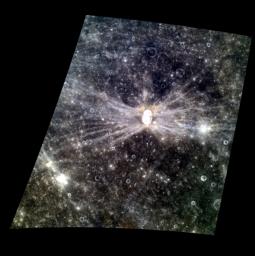
|
RAYdiant Hovnatanian
- Click the image above for a larger view
- Full-Res JPEG (1443 x 1448) (237.1 kB)
- Full-Res TIFF (1443 x 1448) (6.3 MB)
Caption:
Today's color image features Hovnatanian crater , named for Armenian painter Hakop Hovnatanian. The crater's elliptical shape and the bright rays' butterfly pattern indicate that a very oblique impact produced Hovnatanian. The brightness of the rays indicate that they are relatively young features on Mercury's surface.
This image was acquired as a targeted high-resolution 11-color image set. Acquiring 11-color targets is a new campaign that began in March 2013 and that utilizes all of the WAC's 11 narrow-band color filters. Because of the large data volume involved, only features of special scientific interest are targeted for imaging in all 11 colors.
Date acquired:
May 01, 2013
Image Mission Elapsed Time (MET):
9751363, 9751355, 9751351
Image ID:
3986986, 3986984, 3986983
Instrument:
Wide Angle Camera (WAC) of the Mercury Dual Imaging System (MDIS)
WAC filters:
9, 7, 6 (996, 748, 433 nanometers) in red, green, and blue
Center Latitude:
-7.39°
Center Longitude:
172.9° E
Resolution:
394 meters/pixel
Scale:
Hovnatanian crater is about 34 km (21 miles) long.
Incidence Angle:
15.7°
Emission Angle:
40.0°
Phase Angle:
28.0°
Background Info:
The MESSENGER spacecraft is the first ever to orbit the planet Mercury, and the spacecraft's seven scientific instruments and radio science investigation are unraveling the history and evolution of the Solar System's innermost planet. MESSENGER acquired over 150,000 images and extensive other data sets. MESSENGER is capable of continuing orbital operations until early 2015.
For information regarding the use of images, see the MESSENGER image use policy .
Cataloging Keywords:
| Name | Value | Additional Values |
|---|---|---|
| Target | Mercury | |
| System | ||
| Target Type | Planet | |
| Mission | MESSENGER | |
| Instrument Host | MESSENGER | |
| Host Type | Orbiter | |
| Instrument | Mercury Dual Imaging System (MDIS) | |
| Detector | Wide Angle Camera (WAC) | |
| Extra Keywords | Color, Crater, Impact, Radio | |
| Acquisition Date | ||
| Release Date | 2013-07-31 | |
| Date in Caption | 2013-05-01 | |
| Image Credit | NASA/Johns Hopkins University Applied Physics Laboratory/Carnegie Institution of Washington | |
| Source | photojournal.jpl.nasa.gov/catalog/PIA17397 | |
| Identifier | PIA17397 | |
